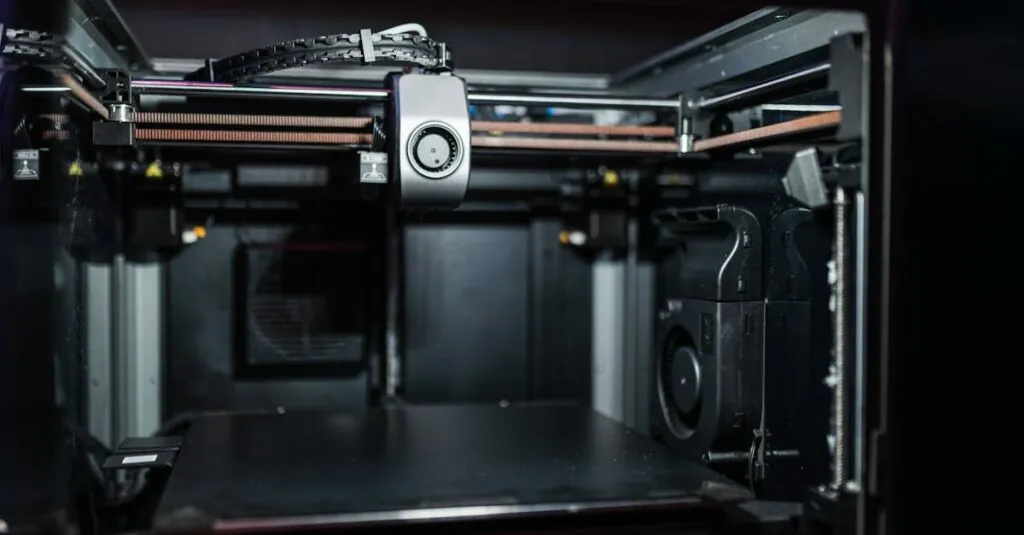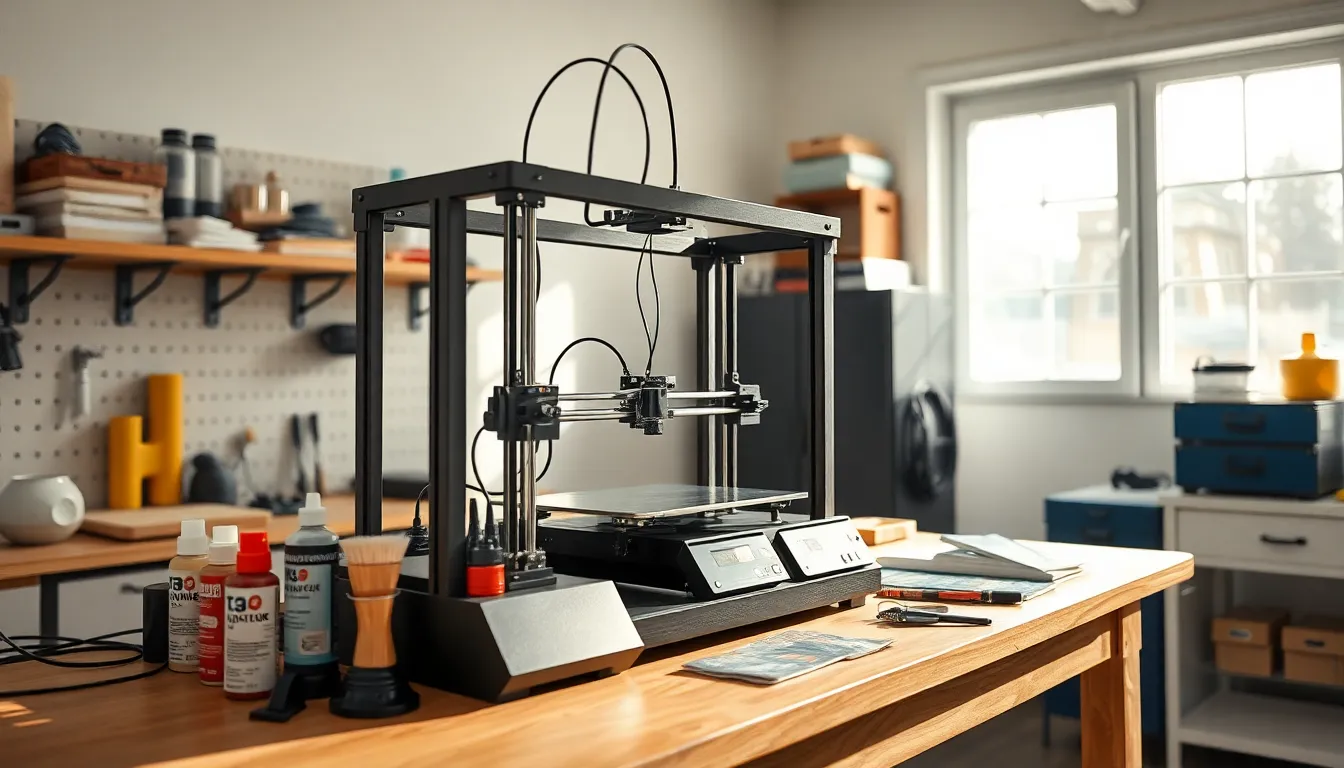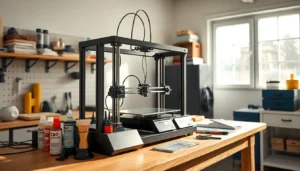In the whimsical world of 3D printing, filament strength is the unsung hero that can make or break a project. Imagine crafting a stunning design only to have it crumble like a cookie under pressure. Not exactly the grand reveal you were hoping for, right? Understanding filament strength isn’t just for the pros; it’s crucial for anyone who wants their creations to stand the test of time—and maybe a little roughhousing.
Table of Contents
ToggleUnderstanding 3D Printing Filament Strength
Filament strength plays a crucial role in the overall performance of printed objects. It impacts the ability of printed parts to endure mechanical stresses and environmental factors. Different materials exhibit varying strengths, affecting the choices available for specific projects.
Polylactic Acid (PLA) remains popular due to its ease of use and decent strength. It offers a tensile strength of around 50 MPa, making it suitable for a range of applications. Acrylonitrile Butadiene Styrene (ABS) boasts higher impact resistance, with a tensile strength of approximately 40 MPa. This quality makes it a go-to for items that require durability.
Nylon displays significant strength, often exceeding 70 MPa in tensile strength. This attribute lends itself to functional prototypes and parts with high wear resistance. PETG also offers good strength, sitting around 50 MPa while providing excellent layer adhesion.
Temperature tolerance contributes to filament strength. Filaments such as ABS and Nylon endure higher temperatures, while PLA tends to deform at lower levels. Understanding these temperature thresholds is essential for ensuring the longevity of printed models.
Manufacturing techniques affect filament strength as well. A well-calibrated 3D printer enhances layer bonding, increasing the overall strength of the finished object. Print speed and layer height influence the quality of layer adhesion, which is vital for creating robust parts.
Choosing the right filament depends on the intended application and performance requirements. Professionals and hobbyists alike benefit from recognizing filament strengths and selecting materials that consistently provide the desired durability and functionality.
Key Factors Influencing Filament Strength
Filament strength relies on several critical factors affecting the durability and performance of 3D printed objects.
Material Composition
Material composition significantly impacts filament strength. Different materials exhibit varying strength characteristics. For example, Polylactic Acid (PLA) provides decent strength around 50 MPa, while Acrylonitrile Butadiene Styrene (ABS) has a tensile strength of approximately 40 MPa. Nylon excels with tensile strength that often exceeds 70 MPa, making it ideal for functional prototypes. PETG stands out with good strength and excellent layer adhesion. Each material’s specific formulation can also enhance or diminish strength properties. Additives included in filaments, such as carbon fiber or glass beads, improve overall strength and robustness.
Printing Parameters
Printing parameters determine how effectively filaments bond and perform. Layer height plays a crucial role; thinner layers generally improve layer adhesion and strengthen the final object. Print speed affects filament cooling and bonding, impacting strength as well. Higher temperatures during printing enhance layer fusion, while inadequate cooling can create weak points. Bed adhesion methods also influence initial layer bonding, affecting overall integrity. Calibration of the 3D printer influences print quality and strength; a well-calibrated machine significantly boosts filament endurance. Fine-tuning these parameters aids in achieving optimal strength for specific applications.
Comparing Different Types of Filaments
Understanding the differences in filament types helps in selecting the best one for specific printing needs. Strength varies significantly among materials, impacting overall print durability.
PLA vs. ABS
Polylactic Acid (PLA) provides ease of use and decent strength, typically around 50 MPa. Acrylonitrile Butadiene Styrene (ABS) demonstrates greater impact resistance, making it suitable for applications requiring toughness at approximately 40 MPa. While PLA is biodegradable and user-friendly, ABS offers better thermal stability and post-processing options. Users often opt for PLA for general use and prototypes, whereas ABS is frequently chosen for functional parts in more demanding scenarios. Different properties cater to varied needs and preferences in printing.
PETG and Nylon
PETG combines good strength with excellent layer adhesion, ideal for projects needing durability without complex handling. Its strength usually ranges from 40 to 50 MPa, making it suitable for both functional and aesthetic applications. Nylon boasts impressive tensile strength, often exceeding 70 MPa, making it perfect for functional prototypes that experience mechanical stress. PETG’s resistance to moisture complements Nylon’s toughness, presenting options based on project requirements, particularly for parts likely to face load and wear. Each filament serves distinct purposes, enhancing versatility in 3D printing.
Testing Methods for Filament Strength
Testing filament strength involves various methods that assess key performance metrics. Two common testing techniques are tensile testing and impact resistance testing.
Tensile Testing
Tensile testing measures a filament’s ability to withstand axial loads without fracturing. During this testing process, a specimen is subjected to increasing tension until it breaks, providing data on maximum tensile strength, which is often expressed in megapascals (MPa). Different materials display varying tensile strength; for instance, Nylon frequently exceeds 70 MPa, while PLA averages around 50 MPa. Understanding these values helps users select appropriate filaments based on specific project requirements. Regular tensile tests ensure consistent quality across batches, allowing for better predictability in printed part performance.
Impact Resistance Testing
Impact resistance testing evaluates how well a filament can absorb energy during sudden impacts. This testing is crucial in applications where strength is vital, such as functional prototypes. A typical test involves dropping a weighted object onto a specimen and measuring the energy absorbed before failure. ABS shows impressive impact resistance at approximately 40 MPa, making it suitable for durable applications. In contrast, PLA, while easier to print, may not perform as well under impact stress. Assessing impact resistance allows users to make informed decisions when selecting filaments based on potential environmental challenges.
Applications of Stronger Filaments
Stronger filaments find diverse applications across industries. These materials revolutionize the production process through enhanced durability.
Prototyping and Manufacturing
Prototyping benefits greatly from stronger filaments. Nylon, with tensile strength often exceeding 70 MPa, proves invaluable for functional prototypes. Strong filaments enable the creation of more resilient parts that can endure testing during the design phase. ABS, known for its impact resistance around 40 MPa, helps manufacturers produce tough prototypes suitable for real-world conditions. Enhanced strength improves the overall reliability of components made using 3D printing. Furthermore, reliable materials ensure higher success rates throughout the manufacturing process. As a result, businesses reduce waste and improve efficiency, which lowers production costs.
Educational Uses
Educational settings leverage strong filaments to provide hands-on learning experiences. Students engage with materials like PLA, recognized for its decent strength of approximately 50 MPa. Stronger filaments facilitate the creation of durable educational models and projects that can withstand frequent handling. Through experimenting with various materials, students learn about the properties of filaments and their practical applications. Furthermore, using robust materials fosters creativity while promoting problem-solving skills. Incorporating specialized filaments can inspire innovative projects in engineering and design classrooms. This approach enhances student comprehension of 3D printing technology and material science.
Conclusion
Understanding filament strength is crucial for anyone involved in 3D printing. The choice of material can greatly affect the durability and functionality of printed objects. With options like PLA for ease of use and Nylon for superior strength, users can tailor their selections based on specific project needs.
Moreover, factors such as printing parameters and material additives play a significant role in enhancing filament performance. By selecting the right filament and optimizing printing conditions, individuals can achieve impressive results that meet both aesthetic and functional requirements. This knowledge empowers both professionals and hobbyists to create reliable and long-lasting 3D printed items.










